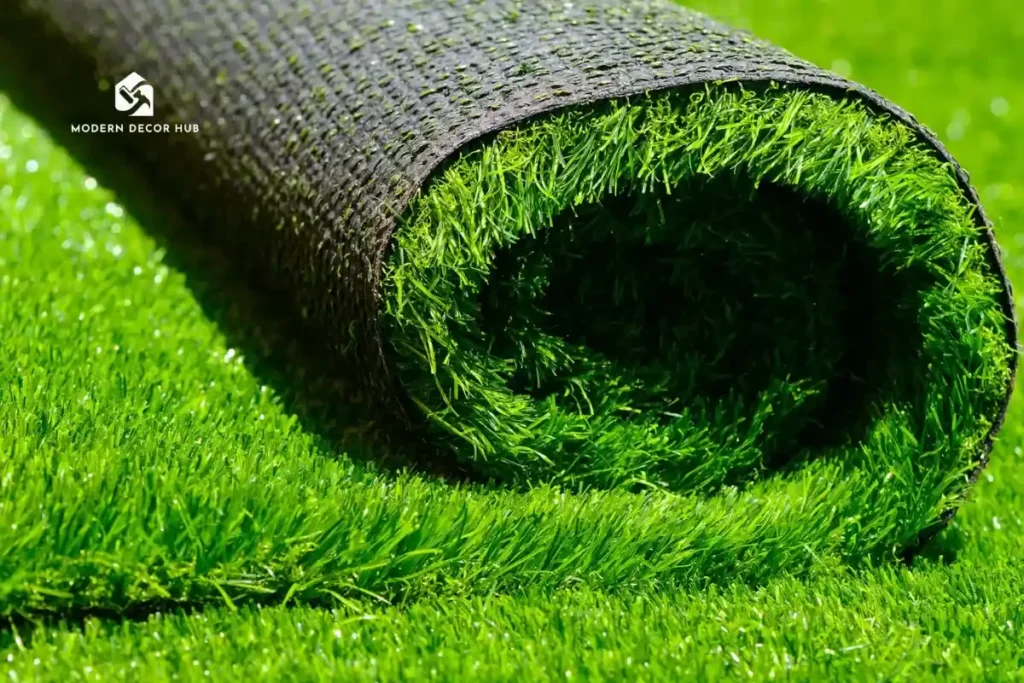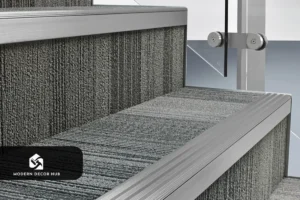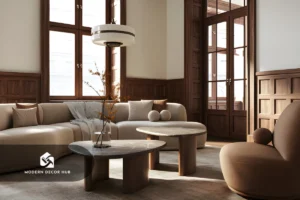Why Choose Artificial Grass & Real Grass Together?
Have you ever looked at your yard & thought, “I love the look of real grass, but keeping it perfect is so much work”? You’re not alone. Combining artificial grass next to real grass gives you the best of both worlds. You get the soft, natural feel of real grass & the low-maintenance, always-green beauty of artificial turf. Sound’s amazing, right? Well, it’s not just a dream—it’s completely doable.
Many homeowners worry that artificial turf next to real grass will look fake or out of place. The truth is with a little planning, the two can blend seamlessly to create a stunning lawn. Real grass brings the authentic vibe you love—perfect for kids to play on or for relaxing afternoons in the sun. Meanwhile, artificial grass handles heavy traffic, stays green all year, & saves you lots of time on watering, mowing, & fertilizing.
Where to Place Artificial Turf & Real Grass
Think about your backyard layout. A strip of artificial grass next to real grass can work wonders along walkways, patios, or areas where pets run the most. This setup reduces wear & tear on your real lawn & keeps your yard looking flawless no matter the season.
Blending artificial turf next to real grass also opens up creative possibilitie’s. You can play with shapes, patterns, & textures to make your yard pop. Imagine a soft natural lawn for relaxing & a durable artificial patch for heavy use—your yard can be both beautiful & practical at the same time.
Understanding Artificial vs. Real Grass
The Basics: Real Grass
Real grass has been the go-to choice for lawns for centuries, and for good reason. It feels soft underfoot, smells fresh, & looks completely natural. Kids love running across it, pets enjoy playing on it, & it naturally cools your yard on hot days. But here’s the catch—real grass requires consistent care. Watering, mowing, fertilizing, & occasional pest control are all part of the package.
When you’re thinking about artificial grass next to real grass, understanding how real grass behaves is key. Some areas of your yard might get more sun, shade, or foot traffic, which affects how healthy the grass grows. Choosing the right type of real grass is essential—some varieties are more drought-resistant, while others recover quickly from heavy use. By knowing this, you can plan where to place your artificial turf next to real grass for the best results.
The Advantages of Artificial Grass
Artificial grass isn’t just for sports fields anymore. Modern artificial turf next to real grass looks incredibly realistic & feels surprisingly soft. The biggest benefit? Minimal maintenance. No mowing, no watering, no fertilizing, & it stays green all year, even during harsh weather.
Another advantage is durability. Areas that see heavy foot traffic, like pathways, play zones, or spots where pets run, can wear down real grass quickly. By adding artificial grass next to real grass, you protect your natural lawn & keep your yard looking perfect all year. Plus, artificial grass can save water—something every U.S. homeowner can appreciate.
Finding the Right Balance
Combining artificial grass next to real grass gives you the best of both worlds. Real grass adds authenticity, fragrance, & a natural feel, while artificial turf provides convenience, durability, & a consistent green look.
When planning your hybrid lawn, think about where each type works best. Use real grass for lounging areas & open spaces where the natural vibe matters most. Place artificial turf in high-traffic zones or spots that are hard to maintain. This balance ensures your yard is both beautiful & practical, letting you enjoy the benefits of each type without compromise.
Planning Your Hybrid Lawn
Step 1: Assess Your Yard
Before installing artificial grass next to real grass, take a good look at your yard. Measure the space, note areas with heavy foot traffic, & consider how much sunlight & shade each section gets. Understanding your yard’s layout is crucial—it helps you decide where real grass should thrive & where artificial turf next to real grass will work best.
Think about your lifestyle too. Do you have kids who play outside often? Pets that love running around? Or maybe you want a stress-free lounging area? Mapping these zones ensures your hybrid lawn is both practical & beautiful.
Step 2: Choose the Right Grass Types
Not all grass is created equal. For real grass, pick a variety suited to your climate & soil. Some grasses are more drought-resistant, while others recover quickly from heavy use.
For the synthetic side, modern artificial turf next to real grass comes in various textures & pile heights, designed to mimic natural grass perfectly. Choosing the right type ensures a seamless look where your real & artificial sections meet. This balance makes your lawn feel natural & inviting.
Step 3: Plan the Layout
Now that you know your zones & grass types, plan the layout. Popular options include strips of artificial grass next to real grass along walkways, around patios, or in high-traffic areas. You can also use curves or geometric patterns to create a modern, stylish design.
Consider adding borders or edging between the real & artificial sections. Materials like timber, pavers, or decorative stones create a clean transition, preventing wear & tear while keeping your lawn looking polished. This small step makes a big difference in achieving a natural, cohesive appearance.
Step 4: Think About Drainage & Maintenance
Even a well-planned hybrid lawn needs proper drainage. Poor drainage can harm real grass & cause water pooling on artificial turf. Make sure your yard has slight slopes or drainage solutions in place.
Maintenance planning is just as important. While artificial turf next to real grass reduces mowing & watering, real grass still needs care. By planning zones wisely, you can enjoy a lawn that’s easy to maintain, visually appealing, & functional for years.
Edge & Transition Solutions
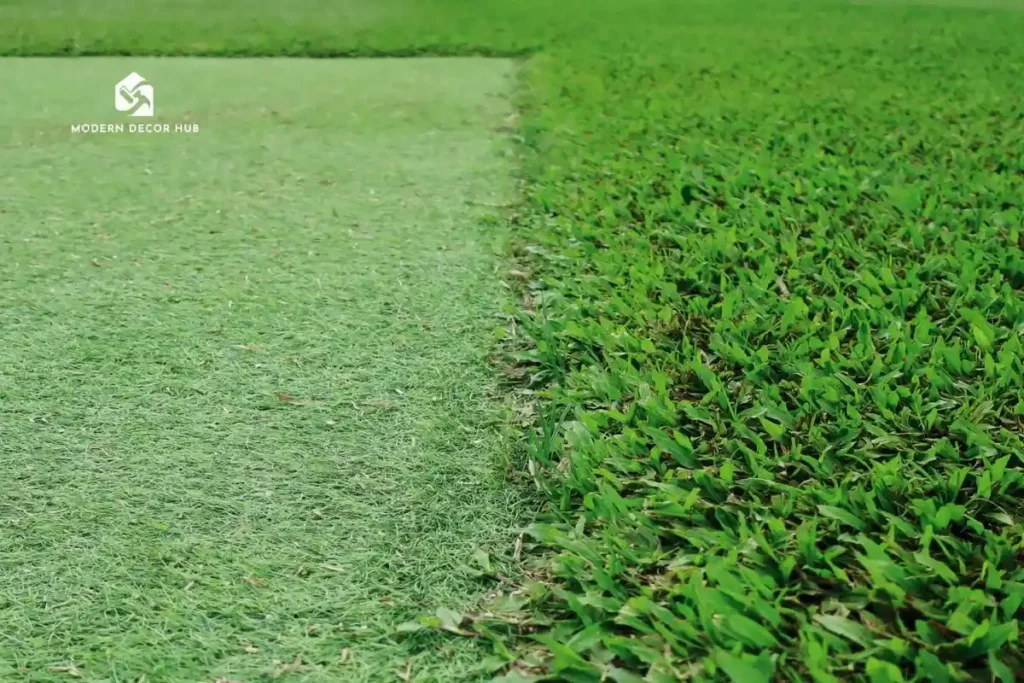
Why Edges Matter
When combining artificial grass next to real grass, edges are more than just borders—they’re the key to a seamless, natural look. Poorly planned edges can make the artificial turf stand out unnaturally or cause the real grass to overgrow into the synthetic section.
Edges also protect both types of grass. A well-defined border prevents wear & tear on real grass while keeping artificial turf next to real grass neat & tidy. Simple solutions can make a huge difference in both aesthetics & maintenance.
Popular Edge Solutions
There are plenty of ways to create clean transitions:
- Timber or Wooden Borders – Easy to install & perfect for curvy or creative layouts.
- Stone or Paver Edging – Adds a decorative touch while providing durability.
- Metal or Plastic Strips – Ideal for modern, minimalistic designs; keeps artificial turf in place.
- Natural Elements – Small rocks, mulch, or flower beds can create a soft, natural transition between artificial & real grass.
Each option has its benefits. Timber adds warmth, stone looks elegant, & natural elements keep the yard playful. Whatever you choose, ensure it’s strong enough to hold the turf securely while letting real grass flourish.
Tips for a Seamless Transition
- Slope & Drainage: Ensure the edge doesn’t trap water. Poor drainage can harm both artificial turf & real grass.
- Height Alignment: Make sure the artificial turf height matches the real grass as closely as possible for a smooth look.
- Regular Maintenance: Trim edges regularly & inspect borders to prevent weeds or grass creeping into the artificial section.
By carefully planning edges, your artificial grass next to real grass will look like it’s always been a part of your yard. The transition should feel natural, letting visitors enjoy a lush, flawless lawn without noticing where one ends & the other begins.
Maintenance Guide
Caring for Real Grass
Even with artificial grass next to real grass, your natural lawn still needs attention to stay healthy & vibrant. Watering is key—most real grasses need about 1–2 inches of water per week. Mow regularly, but don’t cut too short; leaving it around 2–3 inches tall helps it stay green & strong.
Fertilizing every few months can give your real grass a boost, & don’t forget to aerate your lawn to let air & nutrients reach the roots. These simple steps ensure your natural grass thrives next to artificial turf next to real grass, keeping the overall yard lush & inviting.
Maintaining Artificial Grass
The great thing about artificial turf next to real grass is that it’s incredibly low-maintenance. Unlike real grass, it never needs mowing or watering. You can quickly remove debris like leaves, sticks, or pet waste using a leaf blower, broom, or hose.
For high-traffic areas, brushing the fibers occasionally helps them stay upright & keeps the lawn looking fresh. If you have pets, rinsing the turf with water every now & then helps prevent odors & keeps it clean. By following these small routines, your artificial grass remains flawless year-round.
Tips for Hybrid Lawns
Creating a perfect hybrid lawn is about balance. Here are a few tips:
- Trim Edges Regularly – Prevent real grass from creeping into your artificial turf.
- Check Drainage – Make sure water flows properly to avoid puddles or soggy spots.
- Inspect Frequently – Look for signs of wear, weeds, or dirt build-up.
- Combine Tools & Techniques – Use both watering for real grass & quick cleaning for artificial turf to keep the whole yard looking great.
By keeping up with these simple maintenance steps, your artificial grass next to real grass will continue to look vibrant, smooth, & ready for anything—family fun, pets, or just relaxing in your backyard oasis.
Enhancing Your Lawn’s Aesthetic
Adding Design & Texture
One of the most exciting parts of combining artificial grass next to real grass is the design possibilities. You’re not limited to simple rectangular lawns anymore. Try creating curves, geometric patterns, or even checkerboard-style layouts to give your yard personality & style.
Mixing textures is another great idea. Real grass adds softness & natural movement, while artificial turf next to real grass provides a uniform, clean look. The contrast makes your lawn visually interesting, giving it a dynamic feel that draws attention.
Incorporating Landscaping Features
Want to make your hybrid lawn even more inviting? Add flower beds, shrubs, pathways, or small decorative rocks along the edge where your real grass meets artificial grass next to real grass.
Patios, benches, or a small water feature can also enhance the space, creating a functional area for entertaining, relaxing, or letting kids play. These features complement the lush greenery & make your yard feel like a professional landscape, all without requiring excessive upkeep.
Using Color & Seasonal Appeal
Even though artificial turf next to real grass stays green year-round, you can add seasonal color with flowers, planters, or garden decorations. This combination ensures your yard looks vibrant no matter the month.
For real grass sections, choose grass varieties that change subtly with seasons to add a natural rhythm & texture. The key is balance—let artificial grass provide a reliable backdrop while real grass & seasonal elements bring life, warmth, & charm.
By planning your layout, mixing textures, & adding strategic landscaping, your artificial grass next to real grass yard becomes more than a lawn—it becomes an inviting, functional, & beautiful outdoor space that everyone will enjoy.
Environmental & Sustainability Considerations
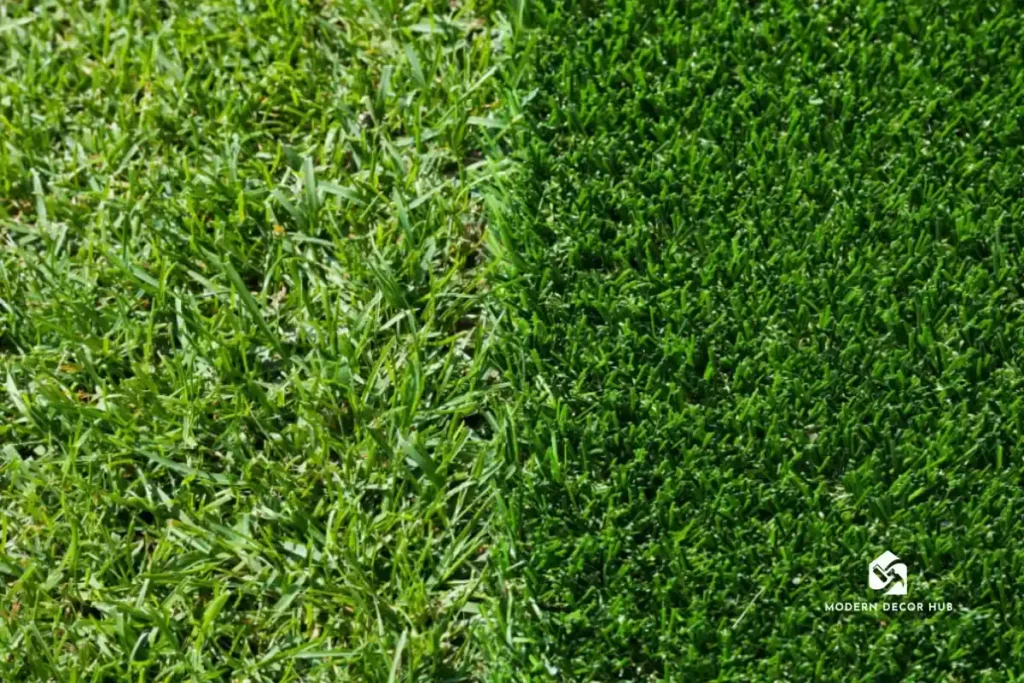
Water Conservation & Eco-Friendly Benefits
One of the biggest advantages of installing artificial grass next to real grass is water conservation. Real grass needs regular watering, which can quickly add up in your utility bills, especially during hot summers. By using artificial turf in high-traffic or hard-to-maintain areas, you drastically reduce water usage, helping both your wallet & the environment.
Artificial grass also eliminates the need for harmful chemicals like fertilizers & pesticides in those sections. Combining artificial turf next to real grass ensures that the parts of your yard that require natural nutrients get them, while artificial areas stay chemical-free. This balance creates a greener, healthier lawn overall.
Reducing Maintenance & Carbon Footprint
Maintaining a hybrid lawn is not only easier—it’s better for the planet. With artificial grass next to real grass, you reduce mowing frequency, which means fewer gas-powered lawnmowers running & less carbon emission. Less water use & fewer chemicals further reduce your yard’s environmental impact.
This setup also minimizes soil compaction in high-traffic zones since people & pets can enjoy artificial turf without damaging the real grass. By carefully planning artificial turf next to real grass, you maintain a lush, functional lawn with a smaller environmental footprint.
Sustainable Lawn Design Tips
- Choose drought-resistant real grass varieties for areas that still need natural turf.
- Recycled or eco-friendly artificial turf options are available, reducing your environmental impact further.
- Smart layout planning ensures that water-intensive areas are minimized, & natural resources are used efficiently.
By implementing these strategies, your hybrid lawn isn’t just beautiful & practical—it’s environmentally responsible. Combining artificial grass next to real grass allows you to enjoy a green, vibrant lawn while conserving water, reducing chemicals, & lowering your carbon footprint.
Final Thought
Combining artificial grass next to real grass gives you the best of both worlds: natural beauty, low maintenance, & year-round green appeal. With proper planning, smart edge solutions, & a little creativity, your backyard can be both functional & stunning.
Whether it’s for kids, pets, or entertaining guests, a hybrid lawn ensures you have a lush, practical, & eco-friendly space. Ready to transform your yard? Start today & enjoy a lawn that’s as beautiful as it is easy to care for.
FAQs
1. Artificial grass next to real grass in Pakistan?
Yes, you can install artificial grass next to real grass in Pakistan by planning the layout & using proper edging. It creates a low-maintenance, visually appealing lawn.
2. Can you put artificial grass next to real grass?
Absolutely! Artificial grass next to real grass can be placed seamlessly with proper preparation, borders, & drainage.
3. Hybrid grass?
Hybrid grass combines real & artificial turf to give you the beauty of natural grass & the durability of synthetic lawn.
4. Artificial grass with real grass?
Installing artificial grass with real grass allows high-traffic areas to stay green while keeping natural sections lush & soft.
5. Can you put artificial grass on soil?
Yes, artificial grass can be placed on soil if you level, compact, & prepare the surface to prevent uneven spots or water pooling.
6. How to join artificial grass to real grass?
You join artificial grass to real grass using edging strips, proper trimming, & a slight overlap to create a smooth, natural transition.

